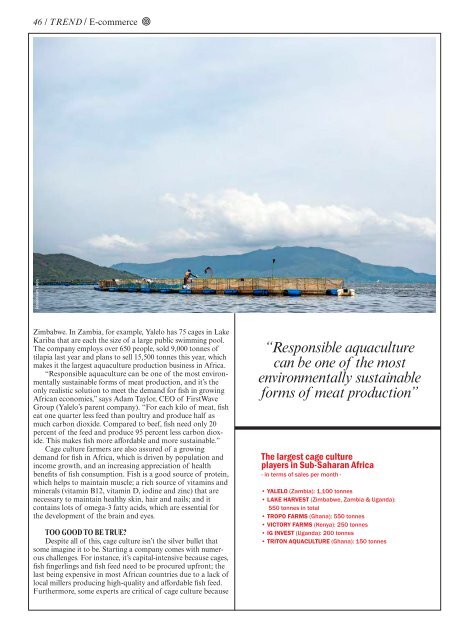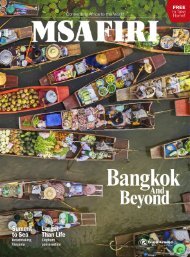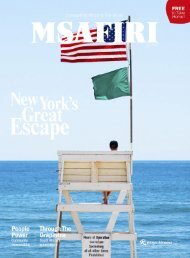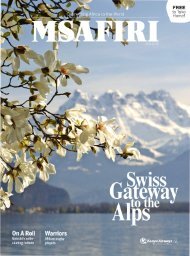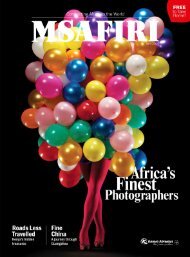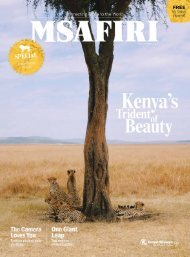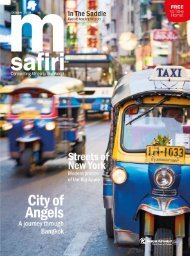You also want an ePaper? Increase the reach of your titles
YUMPU automatically turns print PDFs into web optimized ePapers that Google loves.
46 / TREND / E-commerce<br />
TREND / 47<br />
Jeroen van Loon<br />
Zimbabwe. In Zambia, for example, Yalelo has 75 cages in Lake<br />
Kariba that are each the size of a large public swimming pool.<br />
The company employs over 650 people, sold 9,000 tonnes of<br />
tilapia last year and plans to sell 15,500 tonnes this year, which<br />
makes it the largest aquaculture production business in Africa.<br />
“Responsible aquaculture can be one of the most environmentally<br />
sustainable forms of meat production, and it’s the<br />
only realistic solution to meet the demand for fish in growing<br />
African economies,” says Adam Taylor, CEO of FirstWave<br />
Group (Yalelo’s parent company). “For each kilo of meat, fish<br />
eat one quarter less feed than poultry and produce half as<br />
much carbon dioxide. Compared to beef, fish need only 20<br />
percent of the feed and produce 95 percent less carbon dioxide.<br />
This makes fish more affordable and more sustainable.”<br />
Cage culture farmers are also assured of a growing<br />
demand for fish in Africa, which is driven by population and<br />
income growth, and an increasing appreciation of health<br />
benefits of fish consumption. Fish is a good source of protein,<br />
which helps to maintain muscle; a rich source of vitamins and<br />
minerals (vitamin B12, vitamin D, iodine and zinc) that are<br />
necessary to maintain healthy skin, hair and nails; and it<br />
contains lots of omega-3 fatty acids, which are essential for<br />
the development of the brain and eyes.<br />
TOO GOOD TO BE TRUE?<br />
Despite all of this, cage culture isn’t the silver bullet that<br />
some imagine it to be. Starting a company comes with numerous<br />
challenges. For instance, it’s capital-intensive because cages,<br />
fish fingerlings and fish feed need to be procured upfront; the<br />
last being expensive in most African countries due to a lack of<br />
local millers producing high-quality and affordable fish feed.<br />
Furthermore, some experts are critical of cage culture because<br />
“Responsible aquaculture<br />
can be one of the most<br />
environmentally sustainable<br />
forms of meat production”<br />
The largest cage culture<br />
players in Sub-Saharan Africa<br />
- in terms of sales per month -<br />
• YALELO (Zambia): 1,100 tonnes<br />
• LAKE HARVEST (Zimbabwe, Zambia & Uganda):<br />
550 tonnes in total<br />
• TROPO FARMS (Ghana): 550 tonnes<br />
• VICTORY FARMS (Kenya): 250 tonnes<br />
• IG INVEST (Uganda): 200 tonnes<br />
• TRITON AQUACULTURE (Ghana): 150 tonnes<br />
some companies can chase greater income at the expense of a<br />
more sustainable approach. Overcrowded cages, for example,<br />
can lead to high mortality rates, disease, and parasite infestations.<br />
And contaminants from aqua farms, such as fish excrement;<br />
uneaten, chemical-laden food; and swarms of parasites<br />
might spread to the surrounding water.<br />
To avoid these problems, Rehmann located his farm in a<br />
deep part of Lake Victoria with enough volume to absorb the<br />
fish faeces, and with strong enough currents to flush fresh<br />
water through the cages, maintaining a healthy environment<br />
for the fish. He makes sure not to put too many fish in one<br />
cage and adheres to the lake’s ecosystem by producing Nile<br />
tilapia, which was already introduced in Lake Victoria in the<br />
1950s. “As we use high-quality feed and environmental best<br />
practices, we’re actually seeing an increase in wild fish nearby<br />
and a species of endangered tilapia is being successfully reintroduced<br />
in the waters around our farm,” adds Rehmann.<br />
Government recognition is usually a good barometer of<br />
the feasibility of new methods, and cage culture is already<br />
attracting such attention. Having launched numerous policies<br />
in favour of the emerging cage culture sector, African governments<br />
are now recognising cage culture’s potential. In Kenya,<br />
for example, the local government has invested US$10,000 in a<br />
cage culture project at Chinga Dam. In Ghana, the government<br />
hands out grants to local people to start cage farms. As<br />
a result, around six commercial companies and dozens of<br />
individual entrepreneurs are now using this farming method at<br />
Ghana’s Lake Volta, the largest artificial reservoir in the<br />
world. And the cage system now accounts for 97 percent of<br />
the total fish production in Ghana.<br />
THINK GLOBALLY, ACT LOCALLY<br />
Although the cage culture industry in Kenya is still nascent,<br />
several successful local players have already emerged, such as<br />
Lake View Fisheries (just off Mfangano Island), which Dr<br />
Gilbert Mbeo and his sister Michelle founded. “We grew up<br />
surrounded by a thriving capture fishery, but due to overfishing,<br />
Lake Victoria became less productive, factories closed, people<br />
lost their jobs and malnutrition and poverty became rife,” says<br />
Dr Mbeo. Nowadays, Lake View Fisheries produces 200 tonnes<br />
of fish annually and plans to scale up its operations, employing<br />
hundreds of Kenyans and making thousands of tonnes of<br />
locally produced fish protein available to all Kenyans at an<br />
affordable price.<br />
Taylor – of FirstWave Group – solved the shortage of<br />
affordable, high-quality fish feed by constructing (in partnership<br />
with Danish fish feed company Aller Aqua) Sub-Saharan<br />
Africa’s largest fish feed factory in Zambia. “As fish feed represents<br />
over 50 percent of the costs of operating a fish farm,<br />
it’s very important to have a reliable source of high-quality<br />
affordable fish feed,” says Taylor, who also exports the feed to<br />
Kenya and Uganda, and recently opened his first depot in<br />
Kampala. Yalelo, which sells 70 percent of its fish through 50<br />
Yalelo retail shops throughout Zambia, recently started to export<br />
fish to Democratic Republic of the Congo and intends to<br />
export to several other African countries before the year’s end.<br />
According to Taylor, producing fish locally has countless<br />
benefits above not importing fish from Asia, such as job<br />
creation in low-income areas, a reduction of the carbon footprint,<br />
verifiable quality standards, economic improvement and<br />
improved food security. Rehmann is also optimistic about cage<br />
culture in Sub-Saharan Africa, and he predicts a bright future<br />
for the industry. “We can bring thousands of people into this<br />
industry,” he says. “Cage fish farming could create food selfsufficiency<br />
for Kenya and Uganda in the foreseeable future;<br />
this is how we are going to feed the people.”<br />
8.9<br />
The average annual per capita fish<br />
consumption in Sub-Saharan Africa is 8.9 kg,<br />
compared to a world average of 18.9 kg<br />
21<br />
Sub-Saharan Africa experienced an<br />
average annual growth rate in aquaculture<br />
production of 21% during the last decade<br />
25-50<br />
Most countries in Sub-Saharan Africa<br />
experienced a growth in fish consumption<br />
from around 25–50% between 2007 and 2015<br />
84<br />
Aquaculture production in Sub-Saharan<br />
Africa in 2025 is projected to be one million<br />
tonnes, an increase of 84%<br />
Jeroen van Loon


